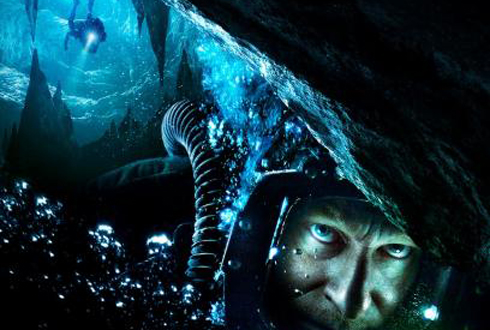Maybe we haven’t been in this exact situation before, but certainly one similar. Sanctum rarely presents any thrills outside the predictable Poseidon-like disaster/adventure film staple and follows a foreseeable route through its maze-like abyss complete with mandatory panicked survivors, expected equipment malfunctions, and inevitable weather complications. It’s still an interesting journey thanks to a decent helping of suspenseful moments, but it’s unfortunate the characters don’t retain the same level of intrigue. Heavy doses of tired dialogue and a few too many annoying, paper-thin personas detract from the tragedy and harrowing action that seeps into the latter half of the film. With James Cameron’s name attached, perhaps the only truly shocking element is the absence of extraterrestrial life.
The enormous and nearly inaccessible caves of Esa Ala contain the last unexplored areas on Earth – and that’s exactly where cave diver Carl Hurley (Ioan Gruffudd) intends to go. Funding a several-month long expedition, Carl hires master caver Frank McGuire (Richard Roxburgh) and his skilled team of explorers to map out the cave system and find a route to the sea. Bringing his girlfriend Victoria (Alice Parkinson) along for a little spelunking fun, Carl joins Frank and his crew for their latest breakthrough to a new section of the cave. But their adventures in exploration quickly turn to a frenzied bid for survival when an unexpected flash flood strikes and the small band of cavers, including Frank’s headstrong son Josh (Rhys Wakefield), becomes stranded in the tunnels. As the caverns rapidly fill with water and the only exit is blocked, Frank determines their only chance for salvation is to head deeper into the uncharted regions of the labyrinth.
“What could possibly go wrong diving in caves?” Victoria rhetorically asks, quite nonchalantly. Apparently she’s never seen a James Cameron film. Although Sanctum is undeniably similar to The Abyss, it’s not without several incredibly suspenseful scenes, a few nasty surprises and breathtaking scenery. To further differentiate itself from other generic thrillers, Sanctum possesses a striking attention to realism not often found in such adventures. While there are certainly creative liberties taken (the true event inspiration is drastically altered), the lingering notions of death, injury and panic are believably presented without the interference of science-fiction elements or timidity when dealing with gut-wrenching dilemmas.
Like a much more intense, complex version of 127 Hours (involving likeminded risk-takers aware of the dangers and therefore harder to sympathize with), Sanctum focuses on multiple fears: claustrophobia, suffocation, the dark, hypothermia, starvation, decompression sickness, inexperience, pain, heights and a few less conventional, surprisingly graphic frights. Differences in opinions turns into creeping dread and finally nerve-wracking panic, each demonstrated with grittiness and high tension. Although the typical nature and construction of the team of cavers – along with their poorly delivered introductory dialogue – spells disaster for the character development and acting categories, once the crew’s mistakes start, the standard snowball effect of disaster movies doesn’t let up. Like many thrillers, the initial momentum of the predicaments is enough to keep audiences on the edge of their seats for the running time despite leaving a truly satisfying conclusion noticeably elusive.

